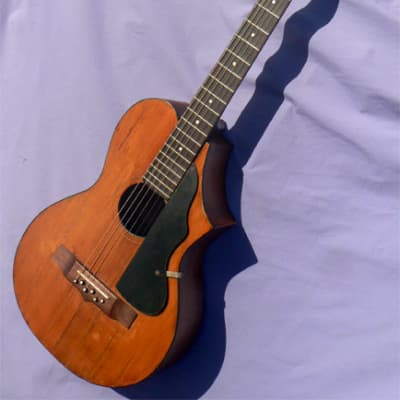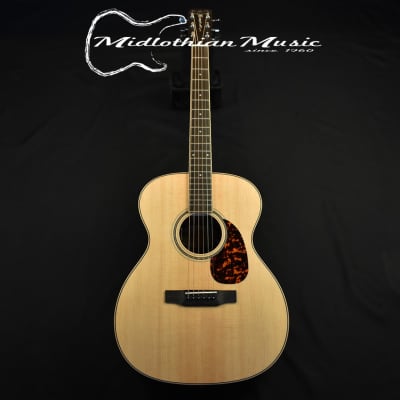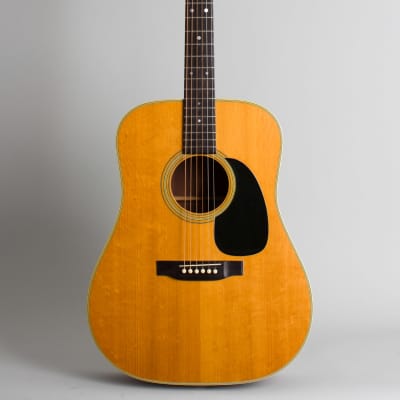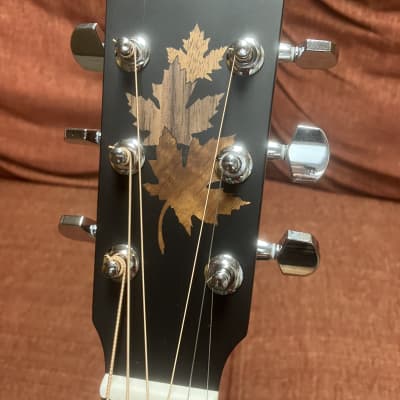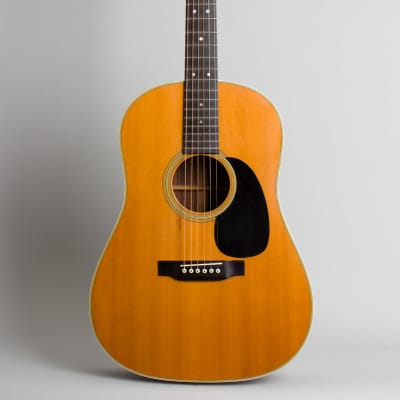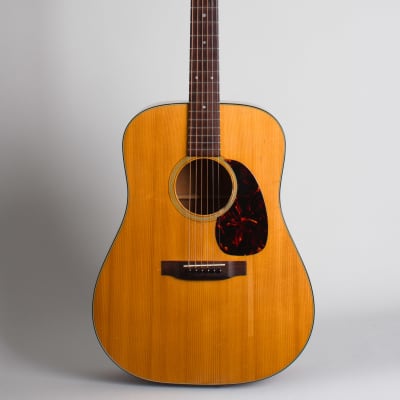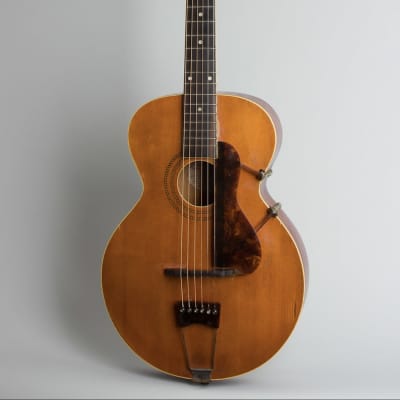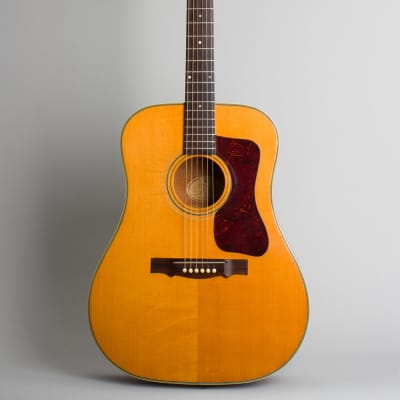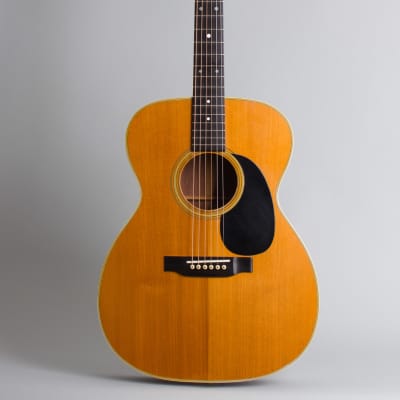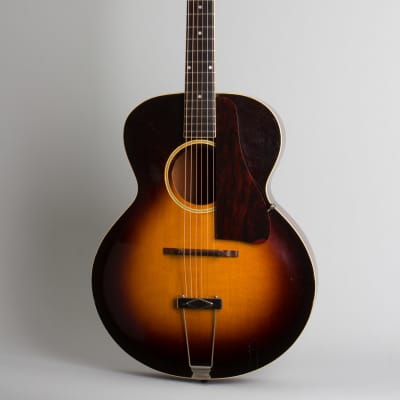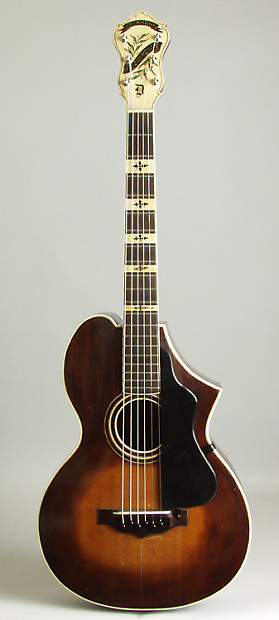

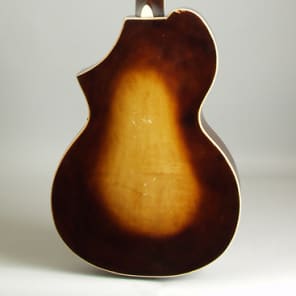
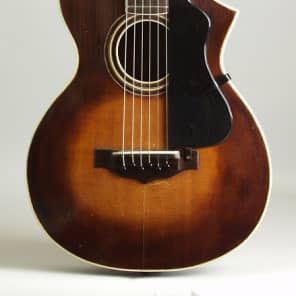
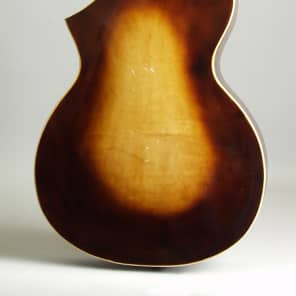
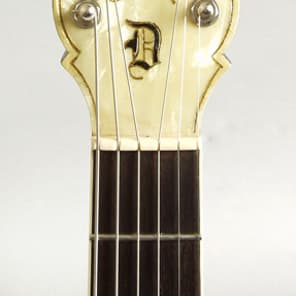
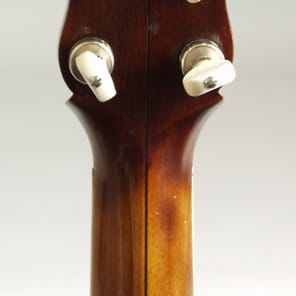
Epiphone Recording Syle D Model Arch Top Acoustic Guitar, c. 1930, made in New York City, serial # 285, sunburst lacquer finish, maple back and sides, spruce top; laminated maple neck with ebony fingerboard, original black hard shell case. Epiphone's Recording model guitars-offered for sale briefly at the end of the 1920's- are some of the most distinctive and original six-strings of their-or any-era. They offered some of the very first arch-top competition to Gibson, and although little remembered today are historically important and aesthetically unique. Very little information has been published about the early Epiphone guitars, and when actual instruments surface, they often contradict the accepted norms. This Epiphone Style D is unlike the few others we have seen, a unique guitar in practically every way.The New York-based Epiphone company had been quite successful building elaborate banjos in the 1920's, rising from a small local family operation to a nationally known player in the fretted world in well under 10 years. Epi Stathopoulo, the company's leader must have seen the coming rise of the guitar before most of his contemporaries, as by the late 1920's this line of fancy and eccentric guitars appeared just as orchestra banjoists were beginning to switch to guitar. The Recording models were offered for sale up through 1931, when Epiphone switched wholesale to the much more Gibson inspired "Masrterbilt" archtop guitar line which was hugely successful. The Recording models became a footnote at that point, seemingly forgotten even by their creators.The Recording Models could certainly be classed as an absolutely original design; with an asymmetric body characterized by a lump scroll on the bass side and a drastically sloping cutaway on the front treble quarter that look like no other guitar before of after 1928. The models were offered in grades A-E, in two different body sizes; this Style D is the next-to-highest grade in the smaller of two body widths. The cosmetics have many similarities to Epiphone banjos of the era, specifically the use of engraved pearloid as a decorative element. There are no surviving records but these guitars were produced in limited numbers and even fewer have survived. The features on Recording Series instruments tend to be very inconsistent-this guitar is no exception. Although the Style D was always listed as having a carved top, this example appears to have a gently arched spruce top bent over curved bracing, re-inforced by a fairly elaborate X brace pattern behind the soundhole. This gives the instrument something of a hybrid tonal character, with some of the warmth of a flat top mixed with the power and projection more typical of an archtop guitar. The body has an arched maple back, and is exactly 14" wide at the lower bout-3/8" wider than the official "concert" size listed in the catalog but smaller than the optional 15" "Auditorium" width. The large banjo-like headstock facing and fingerboard are deeply engraved pearloid with floral wreath patterns enhanced with painted green and gold highlights. All body edges are bound-triple on the top- and the soundhole has a triple-bound edge and multiple celluloid rings. The neck is a 3-ply maple laminate with a bound ebony fingerboard. Overall a totally distinct instrument, offbeat for sure but with an excellent if eccentric sound and a look that stands out from the back of the theatre-as they used to say. Historically important, cool as all get out and a pleasure to play and hear.Overall length is 39 1/8 in. (99.4 cm.), 14 in. (35.6 cm.) wide at lower bout, and 3 1/4 in. (8.3 cm.) in depth, measured at side of rim. Scale length is 25 1/2 in. (648 mm.). Width of nut is 1 11/16 in. (43 mm.). This guitar has had some restoration but remains more original than most of these very rare Recording models, and an excellent playing instrument. The neck has been reset cleanly, and the original pin bridge has a replica moveable saddle fitted. The fingerboard retains the original engraved and painted pearloid inlay strips but had been neatly refretted. The top shows a center seam repair and some of the finish shows touch-up work most notably around the soundhole between the inlaid rings and the fingerboard. Overall the finish shows some light wear and moderate checking, with chips on the back and a number of rubbed-through spots on the edges. The engraved and painted pearloid headstock shows some scuffing and a few small chips-the paintwork shows good color and does not appear to have been touched up. There appear to have been some tuner issues over the years-common to guitars fitted with banjo pegs. Currently fitted are excellent high-grade reproductions of the original 2-band Grovers it would have mounted when new, which both look correct and function excellently. A couple of small holes around the D string area on the back of the headstock attest to a Grover "pancake" peg having resided there at one point. The fragile
Reverb Buyer Protection
Reverb has your back if your item is lost, damaged, or doesn't match its description. Simply report any issues within 7 days and we'll help you get a full refund.Learn more about Reverb Buyer Protection.
| Listed | 8 years ago |
| Condition | Excellent (Used) Excellent items are almost entirely free from blemishes and other visual defects and have been played or used with the utmost care.Learn more |
| Brand | |
| Model |
|
| Finish |
|
| Year |
|
